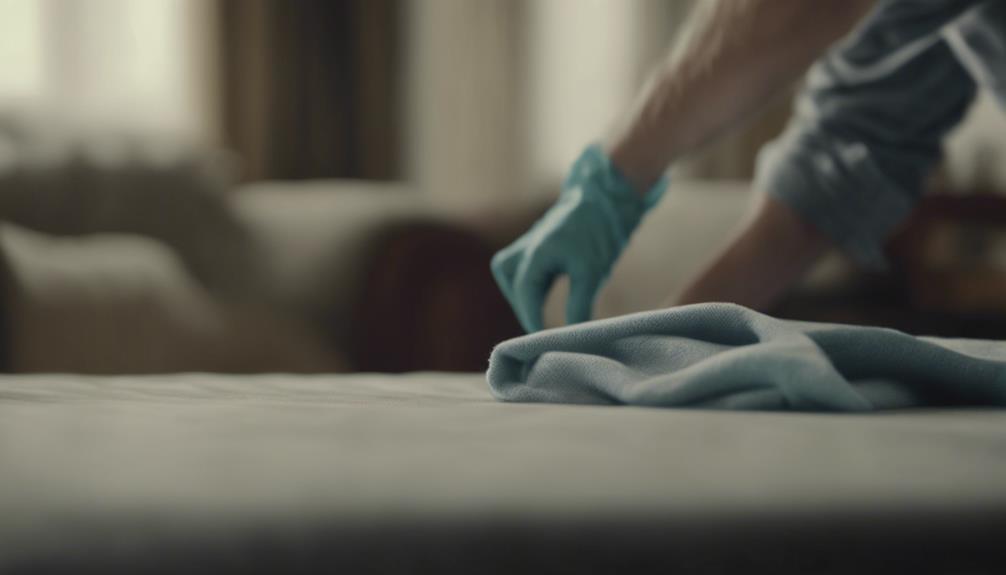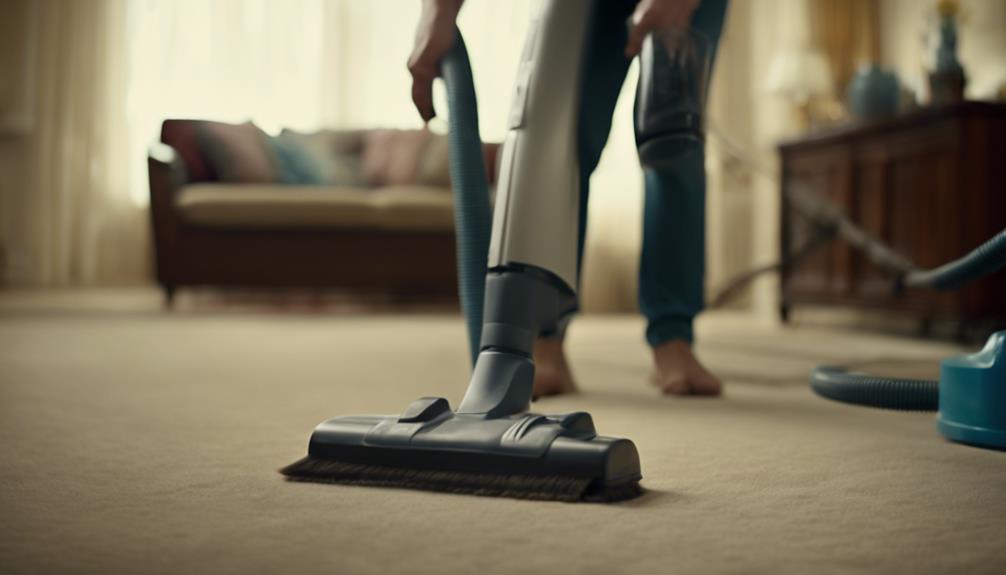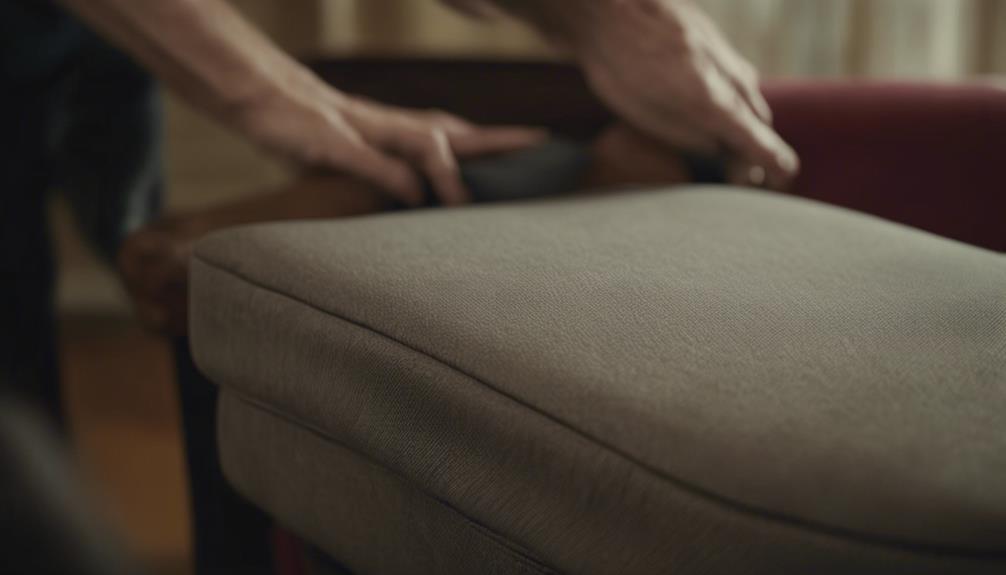To guarantee upholstered dining room chairs, begin by vacuuming or wiping away debris with a microfiber cloth. Spot treat stains using the right cleaner for your fabric type. Consider enzyme-based cleaners for tough food stains. Gently scrub stained areas with a soft-bristled brush in a circular motion. Avoid color transfer by using color-safe solutions and testing in a hidden spot. Air dry upholstery in a well-ventilated area. To learn more maintenance and protection tips, like proper drying techniques and using chair covers, secure the cleanliness and longevity of your chairs.
Vacuum or Cloth Debris Removal
To effectively clean upholstered dining room chairs, start by vacuuming or gently wiping away debris using a microfiber cloth. Use a vacuum with an upholstery attachment to efficiently remove dust and dirt from the chairs. The upholstery attachment helps to reach crevices and corners that may be harder to access with a regular vacuum nozzle. Guarantee thorough coverage by moving the attachment in a back and forth motion across the entire surface of the chairs.
Alternatively, you can opt to use a microfiber cloth for debris removal. Lightly brush the cloth over the upholstery to pick up any loose dirt or dust. Be gentle to avoid pushing debris further into the fabric. This method is ideal for quick touch-ups or for areas where the vacuum attachment may not fit easily.
Regularly vacuuming or wiping down your dining room chairs helps prevent the accumulation of dirt, extending the time between deep cleanings. By starting with this simple step, you set the foundation for a more effective and thorough cleaning process.
Spot Treat Stains With Cleaner
When treating stains on your upholstered dining chairs, it's essential to choose the right cleaner for the job. Make sure to test the cleaner on a hidden area first to confirm it doesn't cause any damage or color fading.
These simple steps can help you effectively tackle stains without risking harm to your chair's fabric.
Choosing the Right Cleaner
Consider the fabric type of your upholstered dining room chairs when selecting a suitable cleaner for spot treating stains. For effective stain removal on dining chairs, opt for an upholstery cleaner or a gentle detergent that's safe for the material of your chair.
Look for cleaners with enzyme-based formulas, as they're particularly effective in breaking down food stains. Before applying the cleaner to the stained area, it's important to test it on a small, hidden section of the chair to confirm it doesn't cause any damage or discoloration.
This precautionary step can help you avoid any potential mishaps and make sure the cleaner is compatible with your chair's upholstery. Always follow the instructions provided by the manufacturer on how to spot clean stains on upholstered dining room chairs to achieve the best results without risking damage to the fabric.
Testing on Hidden Area
Before proceeding with spot treating stains on your upholstered dining room chairs, make sure to test the cleaner on a hidden area to confirm it's safe for the fabric. This simple step can save you from potential damage to the upholstery and guarantee a successful cleaning process.
Here's why testing on a hidden area is important:
- Prevent Damage: Testing on a hidden area helps prevent any unwanted reactions or damage to the upholstery fabric.
- Check Fabric Reaction: Spot treat stains with a small amount of cleaner on the hidden area first to see how the fabric reacts before applying it more broadly.
- Adjust Cleaning Method: By spot treating stains in a discreet area, you can adjust the cleaning method if needed without risking damage to the entire chair.
- Ensure Effectiveness: This precautionary step ensures that the cleaning solution is safe and effective for the specific material of the dining chair.
Use Enzyme-Based Cleaners for Food Stains

For effectively removing food stains on upholstered dining room chairs, consider using enzyme-based cleaners. Enzyme-based cleaners are specifically formulated to target organic stains like food spills and grease marks on upholstery fabrics. These cleaners provide a safe cleaning option, as they're tough on stains but gentle on delicate upholstery materials.
The enzymes in these cleaners work by breaking down the proteins and fats present in food stains, which helps in effectively removing them without causing damage to the fabric.
When dealing with stubborn food stains on upholstered dining chairs, opting for enzyme-based cleaners can be a smart choice. These cleaners offer a reliable solution for breaking down the components of food stains, making them easier to lift from the fabric.
Gently Scrub Stained Areas
When dealing with stubborn food stains on upholstered dining room chairs, gently scrubbing stained areas with a soft-bristled brush is key to effectively removing the stains without damaging the fabric.
Here are some tips to help you tackle those pesky stains:
- Use a soft-bristled brush: Opt for a brush with soft bristles to avoid causing any damage to the fabric.
- Gentle scrubbing: Apply gentle pressure while scrubbing to lift the stains without altering the upholstery.
- Circular motion: Work in a circular motion to target specific areas with stains and guarantee a thorough cleaning process.
- Rinse thoroughly: After scrubbing, make sure to rinse the area thoroughly to remove any remaining cleaning solution and residue.
Avoid Color Transfer and Watermarks

To prevent color transfer and watermarks on your upholstered dining room chairs, use color-safe cleaning solutions and avoid over-saturating the fabric during the cleaning process.
It's important to choose cleaning products specifically designed for upholstery to minimize the risk of colors bleeding onto your chairs. Before applying any cleaning solution, test it in a hidden spot to make sure it won't cause discoloration or watermarks.
When dealing with spills, blot them immediately with a clean cloth to prevent them from spreading and causing permanent stains. Additionally, following the manufacturer's instructions for cleaning your upholstered dining chairs can help you maintain their appearance without the worry of color transfer or watermarks.
Allow Upholstery to Air Dry
When air drying your upholstered dining room chairs, you're ensuring they stay free of moisture and mold. It's essential to choose a well-ventilated spot for best drying results.
To speed up the process, consider using fans or opening windows to promote airflow.
Air Drying Benefits
For best results in cleaning upholstered dining room chairs, consider the benefits of allowing the upholstery to air dry.
Air drying your upholstered dining chairs has several advantages:
- Prevent Damage: Air drying helps prevent damage that can occur from excessive heat or direct sunlight, preserving the quality of the fabric.
- Evenly Drying: It allows the fabric to dry evenly, reducing the risk of wrinkles or shrinkage that may result from uneven drying methods.
- Gentle Method: Air drying is a gentle method that helps maintain the integrity of the upholstery material, ensuring it lasts longer.
- Energy-Efficient: Opting for air drying can be more energy-efficient than using a dryer or other artificial drying methods, saving on electricity costs while being environmentally friendly.
Proper Drying Techniques
Consider the benefits of air drying your upholstered dining room chairs after cleaning to guarantee proper drying techniques are employed.
Air drying is essential to prevent mold and mildew growth on your upholstery. It's important to avoid heat sources like hair dryers or heaters as they can damage the fabric.
Make sure proper ventilation in the room to aid in the drying process and prevent musty odors from developing. To expedite the drying process, if possible, open windows or use fans to help air circulate around the chairs.
Speed up Drying
To hasten the drying process of your upholstered dining room chairs, guarantee proper air circulation and ventilation in the room. Air drying is essential to prevent mold and mildew growth, ensuring your chairs remain in top condition.
Here's how you can speed up the drying process effectively:
- Provide Ample Space: Arrange the chairs in a well-ventilated room where air can freely circulate around each piece.
- Open Windows or Doors: Enhance airflow by opening windows or doors to improve ventilation and aid in the drying process.
- Use Fans: Position fans strategically to help air circulate around the chairs, expediting the drying time.
- Avoid Direct Heat: Refrain from using direct heat sources like heaters or hairdryers, as they can damage the fabric and hinder the drying process.
Regular Cleaning Maintenance

Vacuum your upholstered dining chairs regularly to remove dust and debris accumulated from daily use. This important maintenance routine can help prevent dirt from settling into the fabric and keep your chairs looking clean.
Additionally, spot clean any spills immediately to avoid stains from setting in. Using a mixture of gentle detergent and warm water, gently dab at the spill with a clean cloth to lift the stain without damaging the upholstery. It's vital to test any cleaning products on a small, inconspicuous area of the chair first to make sure they won't cause discoloration or damage.
For a deeper clean, consider professional upholstery cleaning at least once a year, especially for dining chairs that see heavy use. By staying on top of regular cleaning maintenance, you can prolong the life of your upholstered dining chairs and keep them looking fresh and inviting for years to come.
Consider Chair Covers for Prevention
To prevent spills, stains, and general wear and tear on your upholstered dining chairs, one effective solution is to use chair covers. Chair covers offer a protective layer that can be easily removed and washed, keeping your chairs looking fresh and clean.
Here are some key points to keep in mind when using chair covers:
- Variety: Chair covers come in a range of materials, colors, and designs to match your decor style.
- Removability: They're easily removable, allowing for quick cleaning and maintenance.
- Washability: Chair covers are washable, making it convenient to maintain their new appearance.
- Durability: Using chair covers can help prolong the lifespan of your dining room chairs by shielding them from damage.
Rotate Cushions for Even Wear

Consider rotating the cushions on your upholstered dining room chairs regularly to promote even wear and maintain their appearance. By rotating the cushions, you can prolong the lifespan of your chairs and prevent one side from becoming more worn than the other.
This practice helps distribute the weight and usage evenly, leading to a more uniform appearance.
Uneven wear on the cushions can cause structural issues over time, making the chairs uncomfortable to sit in. Rotating the cushions every few months or whenever you notice one side looking more worn than the other can prevent the fabric from becoming permanently creased or stretched in specific areas.
This simple maintenance tip not only keeps your upholstered dining chairs looking better for longer but also ensures that they remain structurally sound and comfortable for everyone using them.
Upholstery Hygiene Tips
To maintain hygiene in your dining room, remember to promptly tackle spills with proper stain removal techniques.
Regularly vacuuming your upholstered chairs will help eliminate dust and debris, keeping them clean and fresh.
Consider utilizing fabric sanitizing methods to make sure your upholstery stays in top condition and free from germs.
Stain Removal Techniques
Use a mixture of warm water and dish soap to gently scrub away stains on your upholstered dining room chairs. When dealing with stains, remember to spot test any cleaning solution first to guarantee it doesn't damage the fabric.
It's crucial to blot stains rather than rub them to prevent them from spreading and setting into the upholstery. For tougher stains that won't budge with gentle cleaning, consider using an upholstery cleaner containing mild ingredients or create a DIY solution with safe components.
By promptly addressing spills and regularly vacuuming your dining room chairs, you can prevent stains from becoming deeply ingrained and maintain the cleanliness and appearance of your upholstery.
- Spot test cleaning solutions before applying
- Blot stains instead of rubbing
- Consider using an upholstery cleaner or gentle homemade solution
- Regularly vacuum and promptly clean spills
Regular Vacuuming Routine
Regular vacuuming plays a crucial role in maintaining the hygiene of your upholstered dining room chairs by removing dust, dirt, and debris that can accumulate over time. To keep your chairs clean and free from allergens and bacteria, it's recommended to vacuum them at least once a week. Chairs used daily may benefit from more frequent vacuuming, while those used sparingly can be vacuumed every 3 months.
When vacuuming, use a soft brush attachment to gently clean the upholstery without causing any damage. This maintenance routine not only guarantees a hygienic environment but also prolongs the lifespan of your dining room chairs, keeping them looking fresh and inviting.
Fabric Sanitizing Methods
Consider enhancing the hygiene of your upholstered dining chairs by incorporating effective fabric sanitizing methods. To keep your dining area clean and inviting, here are some fabric sanitizing methods you can implement:
- Utilize a fabric-safe disinfectant spray: Kill germs and bacteria effectively on your upholstered chairs without damaging the fabric.
- Try steam cleaning: Eliminate allergens, dust mites, and bacteria from your dining chairs for a vital environment.
- Regularly spot clean spills: Prevent dirt and germ buildup by promptly cleaning up spills and stains on your upholstery.
- Use a fabric protector spray: Create a barrier against stains and spills to maintain long-lasting cleanliness on your dining chair upholstery.
Maintaining upholstery hygiene is essential for a welcoming dining space. By incorporating these fabric sanitizing methods into your cleaning routine, you can make sure that your upholstered chairs stay fresh, clean, and germ-free for all your meals and gatherings.
Conclusion
Keep your upholstered dining room chairs looking fresh and clean with regular maintenance and proper cleaning techniques. Remember to vacuum or wipe away debris, spot treat stains promptly, and consider using enzyme-based cleaners for tough food stains.
By following these simple steps, you can guarantee that your chairs stay in great condition for years to come.
For example, Sarah spilled red wine on her dining chair, but by quickly treating the stain with an enzyme-based cleaner, she was able to remove it completely.